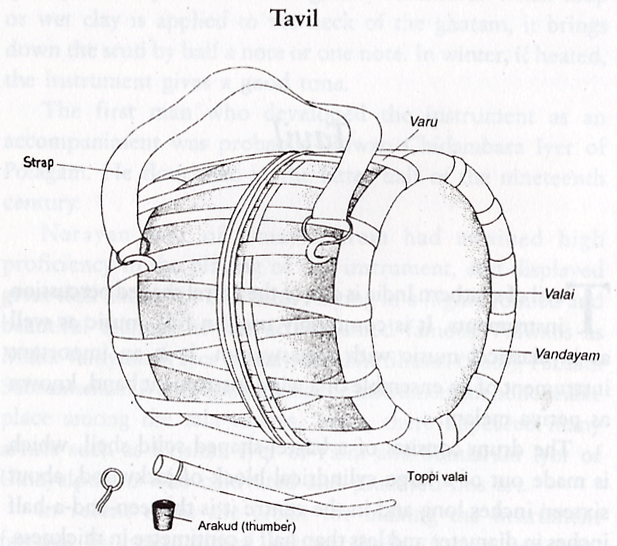Small encyclopedia with Indian instruments
The text is taken from an excerpt of Suneera Kasliwal, Classical Musical Instruments, Delhi 2001
Thavil
Tavil of southern India is one of the barrel shaped percussion instruments. It is commonly used in folk music as well as in classical music with nagaswaram. It is an important instrument of an ensemble of a wind instrument band, known as periya melam.
The drum consists of a barrel-shaped solid shell, which is made out of a large cylindrical block of jackwood, about sixteen inches long and in the centre it is thirteen-and-a-half inches in diameter and less than half a centimetre in thickness. Both the faces of the instrument are almost of the same diameter. The left face of the drum is loaded with a paste on the inside of the drum face to a circular area of two inches. The skins, often in layers, are stretched and stitched over both the faces in a very peculiar manner. The rings or the hoops, fixed over the parchment, consist of a set of six or seven bundled bamboo sticks, bent and tied together with the help of hemp. These hemps are stitched with the skins stretched over both the faces. These hemps are connected with the leather braces. A separate band of leather braces also goes around the middle portion of the drum to tighten the membrane in order to produce the desired pitch. The right head is played by the right hand, wrist and fingers, and the left head is struck with a stick held in the left hand. Occasionally the player wears thumb caps on all the fingers of the right hand.
The stick used on the tavil is hard and is made from the purasai (portia) tree wood. Often played in open air performances, the tavil is hung by a strap from the shoulder of the player.
